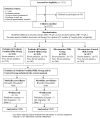Prebiotic and probiotic fortified milk in prevention of morbidities among children: community-based, randomized, double-blind, controlled trial
- PMID: 20730056
- PMCID: PMC2921405
- DOI: 10.1371/journal.pone.0012164
Prebiotic and probiotic fortified milk in prevention of morbidities among children: community-based, randomized, double-blind, controlled trial
Abstract
Background: Recent reviews suggest common infectious diseases continue to be a major cause of death among preschool children in developing countries. Identification of feasible strategies to combat this disease burden is an important public health need. We evaluated the efficacy of adding prebiotic oligosaccharide and probiotic Bifidobacterium lactis HN019 to milk, in preventing diarrhea, respiratory infections and severe illnesses, in children aged 1-4 years as part of a four group study design, running two studies simultaneously.
Methods and findings: In a community based double-masked, randomized controlled trial, children 1-3 years of age, willing to participate, were randomly allocated to receive either control milk (Co; n = 312) or the same milk fortified with 2.4 g/day of prebiotic oligosaccharide and 1.9x10(7) colony forming unit (c.f.u)/day of probiotic Bifidobacterium lactis HN019 (PP; n = 312). Children were followed up for 1 year providing data for 1-4 years. Biweekly household surveillance was conducted to gather information on compliance and morbidity. Both study groups were comparable at baseline; compliance to intervention was similar. Overall, there was no effect of prebiotic and probiotic on diarrhea (6% reduction, 95% Confidence Interval [CI]: -1 to 12%; p = 0.08). Incidence of dysentery episodes was reduced by 21% (95% CI: 0 to 38%; p = 0.05). Incidence of pneumonia was reduced by 24% (95% CI: 0 to 42%; p = 0.05) and severe acute lower respiratory infection (ALRI) by 35% (95% CI: 0 to 58%; p = 0.05). Compared to children in Co group, children in PP group had 16% (95% CI: 5 to 26%, p = 0.004) and 5% (95% CI: 0 to 10%; p = 0.05) reduction in days with severe illness and high fever respectively.
Conclusions/significance: Milk can be a good medium for delivery of prebiotic and probiotic and resulted in significant reduction of dysentery, respiratory morbidity and febrile illness. Overall, impact of diarrhea was not significant. These findings need confirmation in other settings.
Trial registration: ClinicalTrials.gov NCT00255385.
Conflict of interest statement
Figures
References
-
- Bryce J, Boschi-Pinto C, Shibuya K, Black RE. WHO Child Health Epidemiology Reference Group. WHO estimates of the causes of death in children. Lancet. 2005;365:1147–1152. - PubMed
-
- Black RE, Allen LH, Bhutta ZA, Caulfield LE, de OM, et al. Maternal and child undernutrition: global and regional exposures and health consequences. Lancet. 2008;371:243–260. - PubMed
-
- Lopez AD, Mathers CD, Ezzati M, Jamison DT, Murray CJL. Global and regional burden of disease and risk factors, 2001: systematic analysis of population health data. Lancet. 2006;367:1747–1757. - PubMed
-
- United Nations, General Assembly, 56th session. Road map toward the implementation of the United Nations millennium declaration: report of the Secretary General (UN document no. A/56/326) New York: United Nations; 2001.
-
- Bryce J, Black RE, Walker N, Bhutta ZA, Lawn JE, et al. Can the world afford to save the lives of 6 million children each year? Lancet. 2005;365:2193–2200. - PubMed
Publication types
MeSH terms
Substances
Associated data
LinkOut - more resources
Full Text Sources
Medical
Miscellaneous


